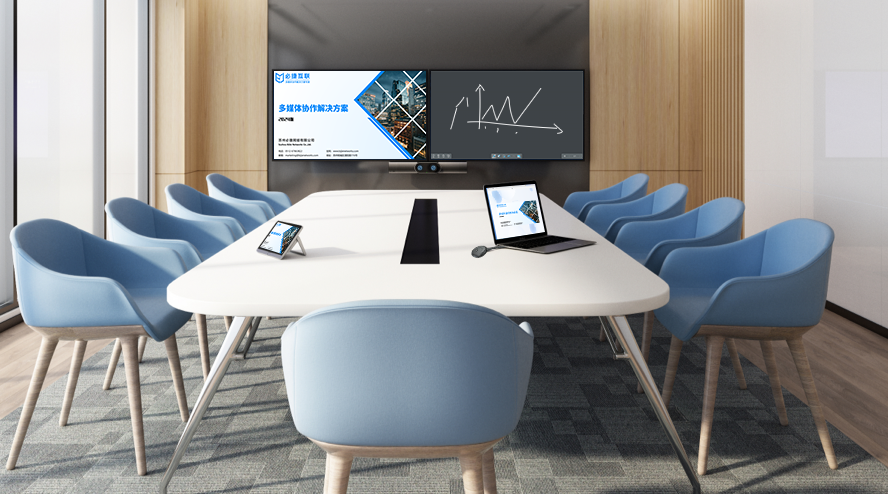AirPlay: A Screen Mirroring Solution for the Apple Ecosystem
The AirPlay screen mirroring solution is built on Apple’s native protocol and designed specifically for Apple devices like the iPhone, iPad, and MacBook. It allows for a seamless flow of content from a small screen to a large one without having to install extra software. With its simple operation and outstanding picture quality, it covers scenarios like the office, classroom, and home, making screen mirroring more convenient for Apple users.
Native Adaptation, Instant Connection
Apple devices have built-in AirPlay functionality, so there’s no need to download any apps or drivers. On an iPhone/iPad, just swipe down from the top-right corner to open the Control Center and tap “Screen Mirroring” or “AirDrop.” On a MacBook, find the AirPlay icon in the menu bar. You’ll quickly find the mirroring receiver, and the connection will be made in 2 seconds with a single click. It’s compatible with the entire range of Apple devices, from the iPhone 11 to the latest iPhone 16 and from a MacBook Air to a MacBook Pro, as well as systems from iOS 13 to macOS Sequoia. It’s not limited by the age, model, or system version of the device.
Clear and Smooth with Outstanding Audio-Video Sync
It supports 1080P Full HD mirroring, and when paired with a high-end receiver, it can even achieve 4K Ultra HD transmission. When you mirror a design draft from your MacBook, the color reproduction is up to 98%, and the lines and textures are clear and delicate. When you mirror a 4K video shot on your iPhone, the picture is smooth with no dropped frames, and dynamic details are accurately displayed. Using Apple’s exclusive transmission protocol, the latency is as low as 15ms, and the audio-video synchronization error is less than 5ms. When playing a movie or a dynamic presentation, the audio and picture are perfectly synchronized, so you won’t experience issues like “delayed audio” or “screen ghosting.” The experience is comparable to a local display.
In-Depth Adaptation for Multiple Scenarios, Functions Meet Your Needs
Office Scenarios: Efficient and Lag-Free Collaboration
- Wireless Presentations: You can use AirPlay to mirror a meeting presentation from your MacBook to a large screen without a cable. During your presentation, you can use the trackpad or gestures to turn pages and zoom in on content, and the large screen will respond in sync. If you receive a client document on the fly, you can directly mirror it from your iPhone, so the meeting doesn’t lose its rhythm.
- Multi-Screen Linkage: You can set your iPad as an “extended screen.” Your MacBook can mirror the main screen to display the proposal outline, while your iPad simultaneously shows data charts, making for more efficient collaboration. When the team is discussing, multiple people can take turns mirroring from their Apple devices, and the seamless, lag-free switching makes comparing proposals more intuitive.
Classroom Scenarios: More Lively Interaction
- Mobile Lessons: A teacher can use their iPad to mirror courseware and walk to the back of the classroom. They can use an Apple Pencil to highlight key points in real time, and the large screen will display the annotations in sync, making them clearer for students. When playing an educational video, AirPlay automatically optimizes the picture quality to ensure it’s clear and the sound is loud.
- Student Presentations: Students can use their iPhones to mirror their homework or lab reports, allowing the whole class to give feedback on the large screen. During group discussions, multiple iPads can mirror in a split-screen view, so each group’s ideas are clear at a glance, making classroom interaction more lively.
Home Scenarios: More Immersive Entertainment
- Large-Screen Viewing: You can mirror a show from your iPhone to your TV. The “picture-in-picture” function lets you mirror a video while using your phone to reply to messages, so they don’t interfere with each other. You can also mirror a local movie from your MacBook, and AirPlay will automatically adapt to the TV’s resolution. When paired with a home audio system, it creates a theater-like experience.
- Parent-Child Interaction: You can mirror children’s picture books and educational cartoons to the TV, and a parent can remotely control the playback and pause to explain things on their iPhone. A child can also mirror their drawings from their iPad, and the whole family can appreciate and comment on them, which enhances communication.
Secure and Convenient Management
- Access Control: An administrator can set a “device whitelist” from a backend to allow only designated Apple devices to mirror content, which prevents unauthorized devices from disrupting a meeting or lesson. It also supports “mirroring password verification,” requiring a password after scanning a QR code to ensure content privacy.
- Smart Memory: The receiver automatically remembers frequently used Apple devices and will show a pop-up to connect when they are nearby, so you don’t have to search again. When a MacBook mirrors content, it can save “mirroring preferences,” and it will automatically match the resolution and volume settings the next time you use it.
- Remote Maintenance: An administrator can remotely view the operational status of AirPlay mirroring devices. It supports online firmware upgrades and remote troubleshooting, so no on-site operation is needed, which reduces maintenance costs.
Whether you’re a heavy user of the Apple ecosystem or an enterprise or school that primarily uses Apple devices, this AirPlay screen mirroring solution can precisely meet your needs and provide a more efficient and smooth mirroring experience with a seamless connection between small and large screens.